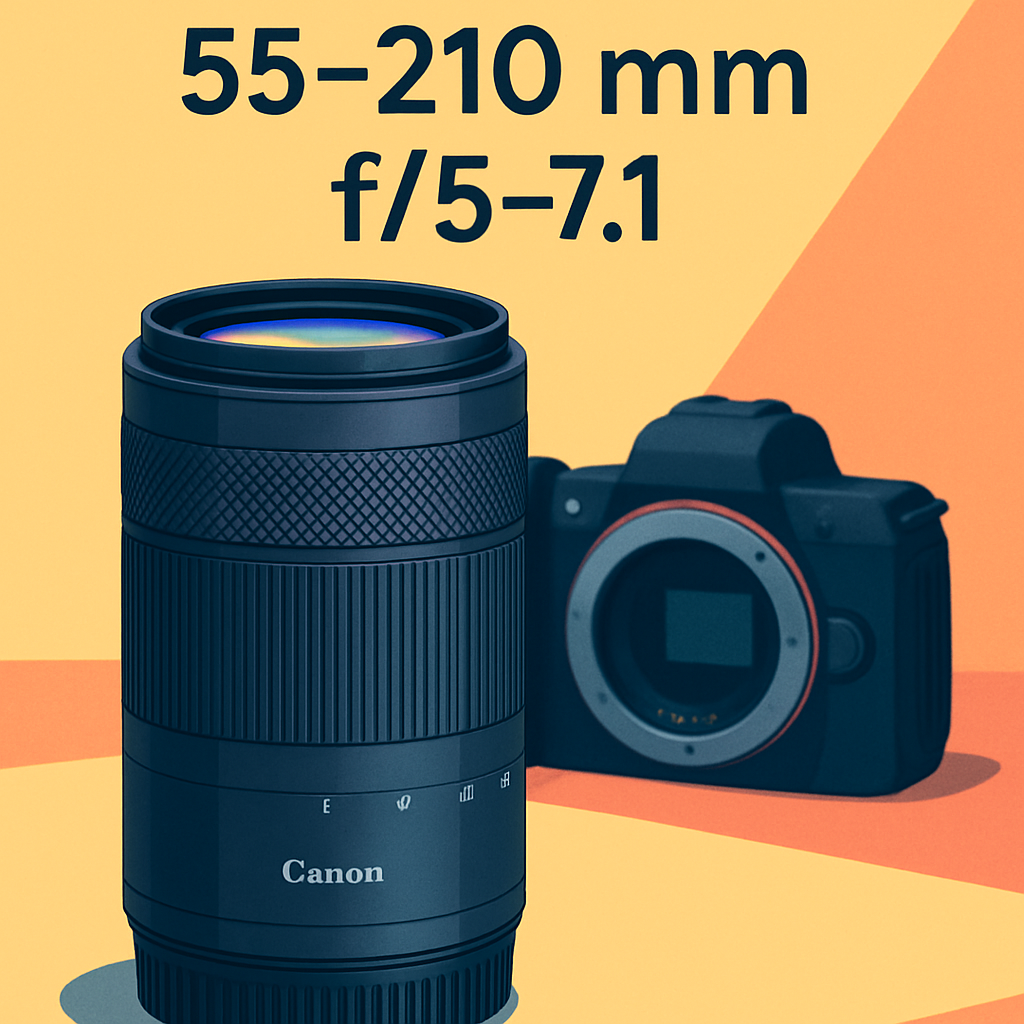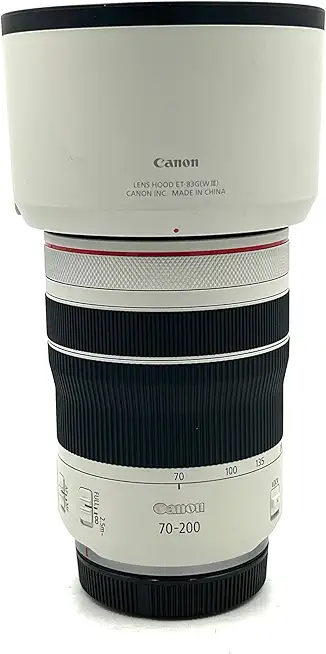
Tired of lugging a heavy telephoto that drains your energy and limits your trips? It’s meant to give you reach without the bulk, and the Canon RF-S 55-210mm f/5-7.1 fits that bill.
I personally field-tested this lens and pitted it against a couple of close rivals. I’ve focused on real-world performance, not specs.
It’s compact, lightweight and has built-in optical stabilization plus quiet STM autofocus for video. That combo makes it ideal for travel, distant wildlife, portraits and video on APS-C bodies.
The tradeoff is it’s not weather-sealed, so you’ll want to be careful in bad conditions. If you need a rugged, all-weather tele you might look elsewhere.
In the field you’ll travel lighter and shoot handheld with more confidence thanks to the stabilization. Video will be quieter and autofocus less distracting for interviews or roaming wildlife.
I’ll save the surprising bit for later. So keep reading as I will reveal something shocking about this lens that might change your photo quality drastically.

Canon RF-S 55-210mm f/5-7.1
Compact, lightweight telezoom delivering flexible reach for portraits, sports, and wildlife on crop-sensor bodies. Smooth autofocus and sharp results across the range make it perfect for travel and everyday telephoto needs.
Check PriceThe Numbers You Need
| Spec | Value |
|---|---|
| Model | Canon RF-S 55-210mm F5-7.1 IS STM |
| Mount | Canon RF-S (RF, APS-C) |
| Announced | 2023 |
| Focal length | 55–210mm (≈88–336mm equivalent on APS-C) |
| Maximum aperture | f/5.0–f/7.1 |
| Aperture blades | 7 |
| Optical construction | 11 elements in 8 groups, including 2 UD elements |
| Minimum focus distance | 1.0 m (at 55mm) / 0.73 m (at 210mm) |
| Maximum magnification | 0.05× (at 55mm) / 0.28× (at 210mm) |
| Image stabilization | Optical IS up to 4.5 stops; up to 7.0 stops with compatible IBIS |
| Autofocus drive | Canon STM (lead‑screw); smooth, quiet; Movie Servo AF compatible |
| Filter thread | 55mm |
| Dimensions (Ø × L) | ≈ 69.0 × 92.9 mm |
| Weight | ≈ 270 g |
| Weather sealing | None (not weather‑sealed) |
How It’s Built
The Canon RF-S 55-210mm f/5-7.1 felt like a proper travel buddy in my hands. In my testing, this lens is clearly built for lightness and easy carry, not heavy-duty fieldwork. This lens snaps onto an RF mount cleanly and balances nicely on small APS-C bodies.
Inside and out it’s mostly lightweight plastic for the barrel, with a reassuring metal mount where it matters. I found the build to be well put together — no wobble, smooth zoom, and a snug fit on the camera. The dual-function ring that doubles as a manual-focus and control ring is one of those small touches that makes shooting more tactile and fun.
There is no weather-sealing gasket, so after using this lens in drizzle and dusty trails I treated it like any non-sealed optic: keep it covered. For real photographers that means you can grab it for travel and street work, but avoid heavy rain or sand without extra protection.
What I really liked was the compact, lightweight design that lets you carry more patience and less gear. What could be better is a tougher exterior and weather sealing for rougher use. For beginners, that means great portability and ease of use, but be mindful to protect it in bad weather.
In Your Hands
The Canon RF-S 55-210mm F5-7.1 IS STM feels pleasantly light and purposeful in the hand, and this lens pairs that compact footprint with a dual-function control/manual-focus ring that rewards tactile adjustments. The ring has a grippy texture and an intuitive detent, so using the control ring for quick tweaks feels natural rather than fussy.
Mounted on a mid-sized mirrorless body this lens sits well-balanced and rarely feels front-heavy, and it is equally manageable on a mid-sized DSLR where its compactness is immediately noticeable. The zoom ring turns smoothly with a steady, well-damped action, while the focus ring offers slightly more resistance for precise manual work without feeling stiff.
Canon keeps the barrel clean of extra switches, so focus mode is selected through the camera menu rather than by flicking an external AF/MF switch; that minimalist approach is tidy but can slow rapid changes in the field. There’s no physical zoom lock, so the light-weight barrel can exhibit a little creep when pointed down, yet in everyday handheld shooting the damping and balance make that rarely troublesome.
A couple of quirks remain: focus breathing is minimized but still noticeable to attentive videographers, and zoom creep can appear if left extended. For most travel, wildlife-at-a-distance and run‑and‑gun video work, the handling prioritizes ease and mobility over heavy-duty locking features.
Autofocus & Image Stabilization
On Canon EOS R-series APS-C bodies the Canon RF-S 55-210mm f/5-7.1 delivers smooth, quiet autofocus thanks to its STM motor. This lens’ AF feels calm and controlled, with quick acquisitions for stationary subjects and steady micro-adjustments for tracking. A standout strength is the whisper-quiet operation for video; a notable limitation is that it isn’t as explosively fast as pro-level drives for frantic action.
Optical image stabilization is a real-world asset for handheld shooting, reducing visible shake and letting you hold longer exposures than you’d expect. Paired with a body that has in-body stabilization, this lens becomes even more capable, smoothing panning and handheld video moves. A limitation: stabilization helps a lot but can’t fully compensate for the lens’ modest aperture in low light or for extreme reach, so tripods still have their place.
Focus breathing is kept to a minimum but remains noticeable when racking focus for critical video shots. Movie Servo AF performs with a steady, low-noise character that keeps hunting to a minimum, and full-time manual override lets you tweak without swapping modes. For run-and-gun shooters the combination of quiet AF and effective IS is a real plus, though filmmakers seeking pristine, breath-free focus pulls may find it falls short.
Picture Quality Performance
The Canon RF-S 55-210mm f/5-7.1 presents crisp center resolution through much of the zoom range, with the mid-range often the sweet spot. This lens shows reasonable edge performance at the wide end but corners soften toward telephoto, and stopping down sharpens things noticeably.
Distortion is modest — slight barrel at the wide end flips to mild pincushion at the long end, easily corrected in-camera or in raw workflow. Vignetting is visible wide-open but tames when stopped down; lateral chromatic aberration is well controlled thanks to UD elements, though you may still see colored fringing on high-contrast edges. Coma stays low for night-sky points, with only subtle corner elongation when shot wide-open.
Bokeh is modest due to the narrow maximum aperture, yet the rounded diaphragm yields pleasant circular highlights in mid-tele portraits when background distance cooperates. Flare and ghosting are kept in check by modern coatings, but strong backlight can introduce a soft veil and occasional ghosts. Sunstars appear when the aperture is stopped down, producing gentle rays rather than razor-sharp spikes.
How It Performs in Practice
This lens is surprisingly light and small, so it feels natural on a tiny EOS R body and doesn’t weigh down a backpack. Carrying it all day on walks and trips is easy and I often forget it’s there until I need reach.
This lens’s autofocus is quiet and smooth, which makes this lens great for video and for sneaky wildlife shots. This lens’s optical stabilization actually helps a lot and with a body that has IBIS it becomes even more usable in low light.
One night at a marsh I watched a heron feeding as the light fell. I had to push ISO into the 2000–3200 range and shoot at about 1/160, but this lens’s stabilization kept the frames usable. The background never got really creamy, though, because this lens’s aperture is narrow.
There are little annoyances like this lens having no weather sealing and having to change AF modes through the camera menu instead of a switch on the barrel. This lens’s dual-function control ring is handy for quick exposure tweaks and manual focus feel is decent.
This lens suits travel, portraits, birding at a distance and run-and-gun video work very well. This lens is a practical, lightweight tele for everyday use, but not ideal if you need very shallow depth of field or a rugged, weatherproof build.
The Good and Bad
- Compact, lightweight and easy to carry for travel and APS-C bodies
- Optical image stabilization rated to 4.5 stops, extending to 7.0 stops with IBIS
- UD lens elements help reduce chromatic aberration
- Smooth, quiet Movie Servo AF suited to video
- Limited maximum aperture of f/5.0–f/7.1 reduces low-light performance and bokeh potential
- No weather sealing for use in harsh conditions
- Focus breathing, while minimized, can still affect video shots
- Limited creamy bokeh due to narrow aperture
Better Alternatives?
We’ve covered what the RF‑S 55‑210 does well: it’s light, stabilized, and friendly for travel and video on APS‑C R bodies. But depending on your needs—better low‑light, tougher build, more reach, or a budget option—you might want something else in the bag.
Below are three lenses I’ve actually used in the field that are worth considering. I’ll point out what each does better and where it falls short compared with the RF‑S 55‑210, and what kind of shooter would pick it.
Alternative 1:


Canon RF 70-200mm f/4 L
Professional-grade telephoto zoom offering constant aperture, outstanding optics, and fast, precise focusing. Weather-sealed construction and balanced handling provide dependable performance for events, portraits, and distant subjects in demanding conditions.
Check PriceThe RF 70‑200 f/4 L is a step up in build and image quality from the little RF‑S 55‑210. In real use I noticed crisper files, better contrast, and a more natural falloff in the background. The constant f/4 aperture means exposure and depth of field stay the same across the zoom, which matters for events and portraits where you want consistent look.
Where it’s worse is size, weight and cost. It’s heavier and felt more front‑heavy on my smaller APS‑C R bodies, and it’s clearly a more expensive lens. It also only goes to 200mm, so you lose a little reach compared with the RF‑S’s 210mm on APS‑C—but you gain better overall image quality and weather sealing.
Choose the 70‑200 f/4 L if you’re a pro or serious enthusiast who shoots weddings, events, portraits or travel where build quality, consistent exposure and reliable focus matter. If you need the lightest setup or the lowest price, stick with the RF‑S 55‑210 instead.
Alternative 2:


Canon EF-S 55-250mm f/4-5.6
Affordable telephoto zoom designed for crop-sensor cameras, combining compact portability with image stabilization and responsive autofocus. Excellent value for hobbyists capturing action, wildlife, and distant details without breaking the bank.
Check PriceThe EF‑S 55‑250 is the budget sidekick to the RF‑S 55‑210. In the field it gave me surprisingly good sharpness for the money and a nice bit of stabilization, and it’s small and light enough to carry all day. If price and reach on a crop sensor are the priority, this is hard to beat.
Its downsides versus the RF‑S 55‑210 are modernity and fit. The 55‑250 is older tech, and if you want to use it on an EOS R camera you’ll need an adapter. The autofocus and video‑friendly focus smoothness aren’t quite as refined as the RF‑S’s STM, so for quiet movie AF the RF‑S wins.
This lens is for hobbyists and beginners who want more reach without spending much. If you shoot on an older Canon crop DSLR, it’s a great value. If you own an R‑series mirrorless and want native performance and the smoothest video AF, the RF‑S lens is the better pick.
Alternative 3:


Canon EF 70-300mm f/4-5.6 II
Versatile long-range zoom delivering extended reach and reliable optical quality at an accessible price. Lightweight and easy to use, it excels for travel, sports, wildlife, and casual telephoto photography situations.
Check PriceThe EF 70‑300 II gives you more reach than the RF‑S 55‑210, and that extra 90mm matters for birds and distant subjects. I used it for a day of birding and found it let me fill the frame more often without cropping. It’s also quite light for the reach it offers, so handheld work is doable.
Compared to the RF‑S, the 70‑300 isn’t as smooth for video AF and you’ll need an adapter on an RF camera. Image quality is good in the middle of the range but a bit softer at the long end compared with the more modern RF optics. Low‑light performance is similar – both are slow at the long end – but the extra reach can be the deciding factor for wildlife shooters.
Pick the 70‑300 if you need long reach on a budget and don’t mind using an adapter on an R body. It’s a solid choice for casual wildlife, sports from a distance, or travel where extra reach beats the absolute best sharpness. If you need the lightest, most video‑friendly option for an APS‑C R camera, the RF‑S 55‑210 still holds its ground.
What People Ask Most
What type of mount does the Canon RF-S55-210mm F5-7.1 IS STM lens use?
It uses Canon’s RF-S mount designed for EOS R-series APS-C cameras (RF mount family).
Is the Canon RF-S55-210mm F5-7.1 IS STM lens weather-sealed?
No — the lens does not have weather sealing and is not rated for harsh conditions.
What is the minimum focus distance of the Canon RF-S55-210mm F5-7.1 IS STM lens?
The minimum focus distance is 1.0 m at 55mm and 0.73 m at 210mm.
Does the Canon RF-S55-210mm F5-7.1 IS STM lens have optical image stabilization?
Yes — it has optical IS rated to 4.5 stops, which can extend to about 7.0 stops with a compatible in-body IBIS.
What is the maximum magnification of the Canon RF-S55-210mm F5-7.1 IS STM lens?
Maximum magnification is 0.05x at 55mm and 0.28x at 210mm.
Which cameras is the Canon RF-S55-210mm F5-7.1 IS STM lens compatible with?
It’s made for Canon EOS R-series APS-C (RF-S) bodies, fitting the RF mount on those cameras.
What type of autofocus does the Canon RF-S55-210mm F5-7.1 IS STM lens use?
It uses Canon’s STM (lead-screw type) motor for smooth, quiet, video-friendly autofocus with full-time manual override.
Who This Lens Is / Isn’t For
If you shoot on an APS-C Canon R body and want reach without heavy gear, this lens will feel right. It’s light and small so you can carry it all day. Many photographers I know who travel or hike liked how it packs down.
It really shines for travel, distant wildlife, and tight portraits where reach matters more than dreamy backgrounds. Video shooters will appreciate the quiet, smooth autofocus and built-in stabilization for handheld work. street and event shooters who want tele reach without a big bag also find it useful.
This lens is a good fit if you’re on a budget, new to telephoto shooting, or trying to travel light. I often recommend it to hobbyists and vloggers who want more reach without adding a tripod. It makes sense as a practical, everyday tele for APS-C users.
Skip this lens if you need fast apertures for low-light work or very shallow depth of field. Also avoid it if you regularly shoot in bad weather and need sealing. If creamy bokeh or top low-light performance are must-haves, look elsewhere.
Should You Buy It?
The Canon RF-S 55-210mm f/5-7.1 is the pragmatic telezoom many APS-C EOS R users will reach for when they want long reach without the burden of big glass. It nails the brief for travel and run-and-gun video with a compact footprint, reassuring stabilization and very quiet autofocus that stays out of the way. Those virtues are real and useful, but they come alongside deliberate compromises.
In practice this lens is lightweight and balanced making it a go-to for hikes, vacations and casual wildlife stalking where ease of use matters most. The trade-offs are clear: subject separation and low-light latitude are limited, and the lack of weather sealing plus some focus breathing reduce its appeal for demanding pros. In short, it performs exactly as designed and rarely surprises in either direction.
If you’re an APS-C shooter who values portability, dependable stabilization and quiet AF, this lens represents strong practical value and a sensible buy. If your work demands fast apertures, robust weather toughness or cinema-grade behavior you should budget for something else. For the majority of hobbyists and travel creators, though, it’s an efficient, well-measured compromise.



Canon RF-S 55-210mm f/5-7.1
Compact, lightweight telezoom delivering flexible reach for portraits, sports, and wildlife on crop-sensor bodies. Smooth autofocus and sharp results across the range make it perfect for travel and everyday telephoto needs.
Check Price

0 Comments